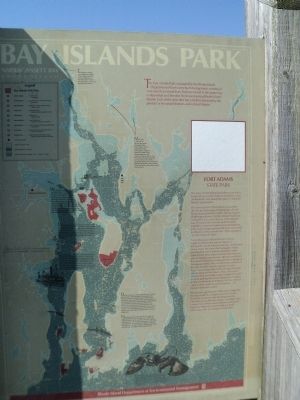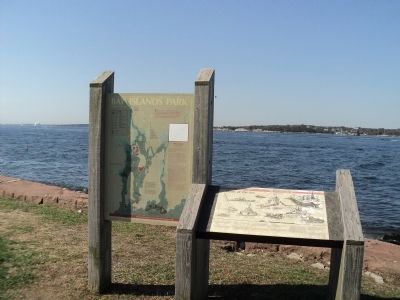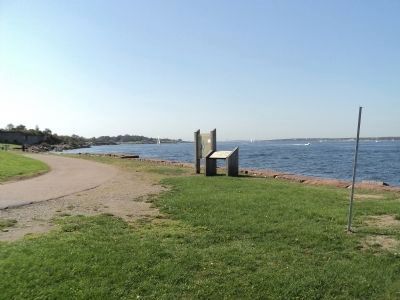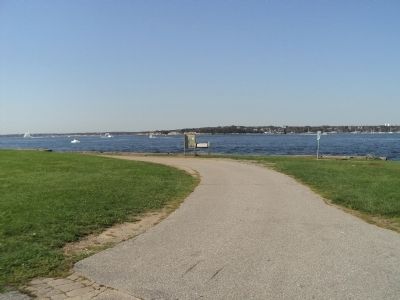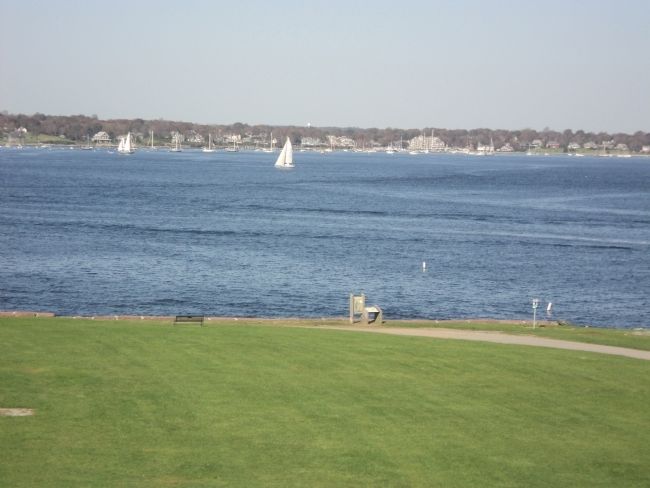Newport in Newport County, Rhode Island — The American Northeast (New England)
Bay Islands Park
The Bay Islands Park, managed by the Rhode Island Department of Environmental Management, consists of nine sites that extend from Patience Island in the upper bay to Beavertail and Brenton Point overlooking Rhode Island Sound. Each of the nine sites has a distinct personality, the product of its natural features and cultural legacy.
The shipping channel was dredged to a depth of forty feet by the Army Corps of Engineers so that deep-draft oil tankers and cargo ships could reach the port of Providence.
More than 2,000 acres of salt marshes border Narragansett Bay. These areas, with their lush growth of salt marsh grasses, support a variety of wildlife. Some animals depend on salt marshes for their existence; one kind of bird, the seaside sparrow, can nest only in salt marshes. Some other birds, such as the snowy egret and glossy ibis, nest on islands in the bay but fly to the marshes where they find food.
With bullrakes and tongs, the shellfishermen work the floor of the bay where quahogs feed and grow in the sediment. The warm waters of upper Narragansett Bay are particularly suitable for quahogs since these waters support large populations of microscopic floating plants that are eaten by quahogs. Commercial quahoggers are able to harvest about two million pounds of quahogs (meat weight) annually from the floor of the bay, accounting for 10% of the quahogs marketed in the entire country.
In 1980 Hope Island, Patience Island, and the north end of Prudence Island became the Narragansett Bay National Estuarine Sanctuary, one in a series of sanctuaries dotting the Atlantic and Pacific coasts. As part of the national estuarine sanctuary system, these areas in the bay will be preserved in their natural state as places where scientists, students, and the public can learn about this complex ecosystem.
Cruising Narragansett Bay on a steam-powered pleasure boat was a popular way to spend a Sunday during the late 1800s. People from all over Rhode Island took trains to Providence where they would board one of the many steamers that left the city every half hour. On a sunny summer afternoon, as many as 50,000 people cruised the bay on these steamboats. Now, one hundred years later, Rhode Islanders again view the bay from ferries that stop at the Bay Islands Park.
During World War II, Gould Island became a torpedo testing facility capable of testing 100 torpedoes a day. These were fired up the bay towards Prudence Island. Sometimes military personnel used a low-flying blimp to observe the performance of the torpedoes. The testing area was outlined on nautical charts since the area was off-limits to commercial and recreational boats. The Gould Island Testing Station was one of the many military facilities in lower Narragansett Bay during World War II. After the war, some of these sites became part of the Bay Islands Park.
Nine thousand years ago, sea level was about one hundred feet lower than it is today since much of the world’s water was frozen on land in the form of glaciers. At that time salt water reached northward in the bay only to Gould Island, as indicated by the depths on the chart. The upper East and West Passages were freshwater stream channels that carried glacial melt water to the sea.
Fort Adams State Park
The story of Fort Adams provides a view into a period of our nation’s history and allows us to understand more clearly this place of natural historic significance.
The construction of Fort Adams was linked directly to the burning of Washington by the British during the War of 1812. The burning of Washington proved that the United States was vulnerable to an attack by sea. Following the war, President Monroe was determined to establish a system of national coastal defenses, and Congress appropriated the necessary funds to initiate construction for the “higher purpose of preventing war itself.”
Simon Berard, a brilliant French military engineer and former aide to Napoleon Bonaparte, was hired to oversee the fortification of our coast. He knew that Narragansett Bay provided the finest harbors along the entire coast of the United States and was, therefore, an area of strategic significance. Berard considered this point of land overlooking the East Passage of Narragansett Bay to be crucial for the defense of the bay. Another French engineer, Joseph Totten, was assigned by Berard to supervise the construction of Fort Adams. After 33 years of construction, Fort Adams was completed in 1857 and was perhaps the finest statement of military architectural theory in America. Its three tiers of cannon were ready for a sea invasion - - an invasion that never came.
The historic significance of this fort is judged by the way in which a unique set of events and decisions resulted in the development of a national coastal defense system. Fort Adams was a major link in that coastal defense system and may have helped in “preventing war itself” which was, after all, Congress’s objective.
Erected by Rhode Island Department of Environmental Management.
Topics and series. This historical marker is listed in these topic lists: Forts and Castles • Waterways & Vessels. In addition, it is included in the Former U.S. Presidents: #05 James Monroe series list. A significant historical year for this entry is 1980.
Location. 41° 28.833′ N, 71° 20.3′ W. Marker is in Newport, Rhode Island, in Newport County. Marker can be reached from Fort Adams Drive, on the left when traveling north. Marker is located in Fort Adams State Park, on the waterfront on the north side of the fort. Touch for map. Marker is in this post office area: Newport RI 02840, United States of America. Touch for directions.
Other nearby markers. At least 8 other markers are within walking distance of this marker. Boats of the Bay (here, next to this marker); Fort Adams (about 300 feet away, measured in a direct line); Three Tiers of Firepower (about 500 feet away); Going Great Guns (about 500 feet away); The Irish Connection to Fort Adams (about 500 feet away); Defending Narragansett Bay (about 500 feet away); a different marker also named Defending Narragansett Bay (about 500 feet away); Returning Old Glory 2001 (about 500 feet away). Touch for a list and map of all markers in Newport.
More about this marker. The background of the marker features a map of Narragansett Bay, with the depths on the water indicated. The nine sites that make up Bay Island Park are labeled.
Credits. This page was last revised on November 2, 2020. It was originally submitted on October 17, 2011, by Bill Coughlin of Woodland Park, New Jersey. This page has been viewed 1,062 times since then and 18 times this year. Photos: 1, 2, 3, 4, 5. submitted on October 17, 2011, by Bill Coughlin of Woodland Park, New Jersey.
